BYD Dolphin Dynamic Standard first drive: This RM100,000 EV ticks all the right boxes (VIDEO)
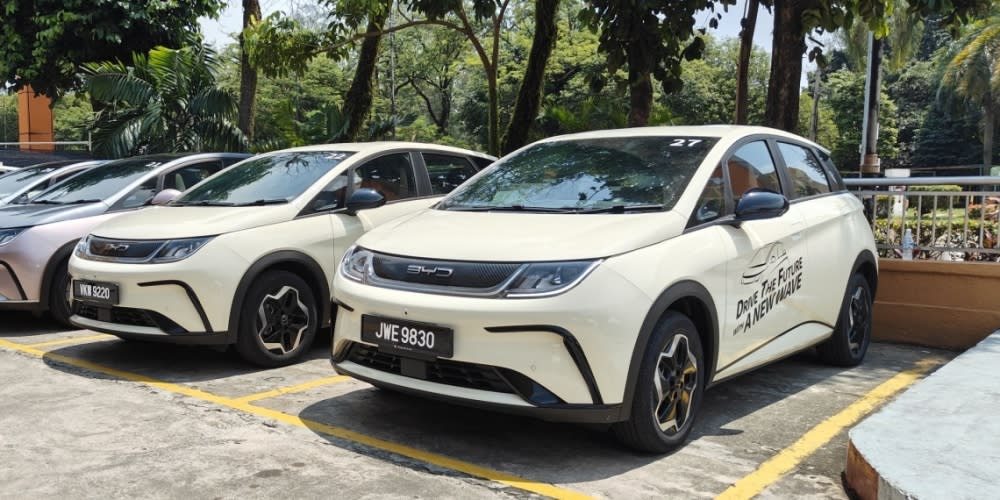
KUALA LUMPUR, Aug 6 — During the launch of the BYD Dolphin last week we managed to get behind the wheel of the Dynamic Standard model which is priced just a hair above RM100,000. While the Neta V is still the cheapest EV in terms of price, the Dolphin is significantly better for just RM100 extra and it is a serious contender for those looking for a new car that’s priced at RM100,000.
Design first impressions
Being the cheaper of the two Dolphin options available, the Dynamic Standard variant gets a single-tone body colour but you do get a blacked-out rear pillar to give it a “floating roof” appearance. BYD has gone with a more conservative look for the front with flat LED headlamps which some said looks like the Proton Waja. However, it does get thin LED strips around the headlamps and middle closed-off grille, so you’ll definitely know that this isn’t an internal combustion engine car.
While the front is nothing to shout about, the rear of the Dolphin is the best angle yet. It gets an LED array that stretches the full width and it gets a rather interesting pattern for the brake lights. Unlike the Atto 3 which has the large “Build Your Dreams” letterings on the metal bodywork, Dolphin uses a Porsche-inspired approach by placing the “brand” within the lighting elements. In case you’re wondering, the new “Build Your Dreams” nameplate is placed underneath the clear plastic housing.
If you think the BYD Atto 3’s interior is just over the top with weird muscle patterns and guitar strings, you’ll be happy to know that the Dolphin gets a much more sensible interior. It features a more conventional compact hatch dashboard design with circular aircon vents mounted on the top and it still gets a very large 12.8″ touchscreen infotainment display which can also rotate between portrait and landscape mode at a push of a button. The large screen also supports wired Apple Car Play via USB and we are told that Android Auto is coming later via an OTA update.
Unlike the premium model, the standard Dolphin lacks a wireless charging pad but you do get USB-C and USB-A charging ports for both front and back.
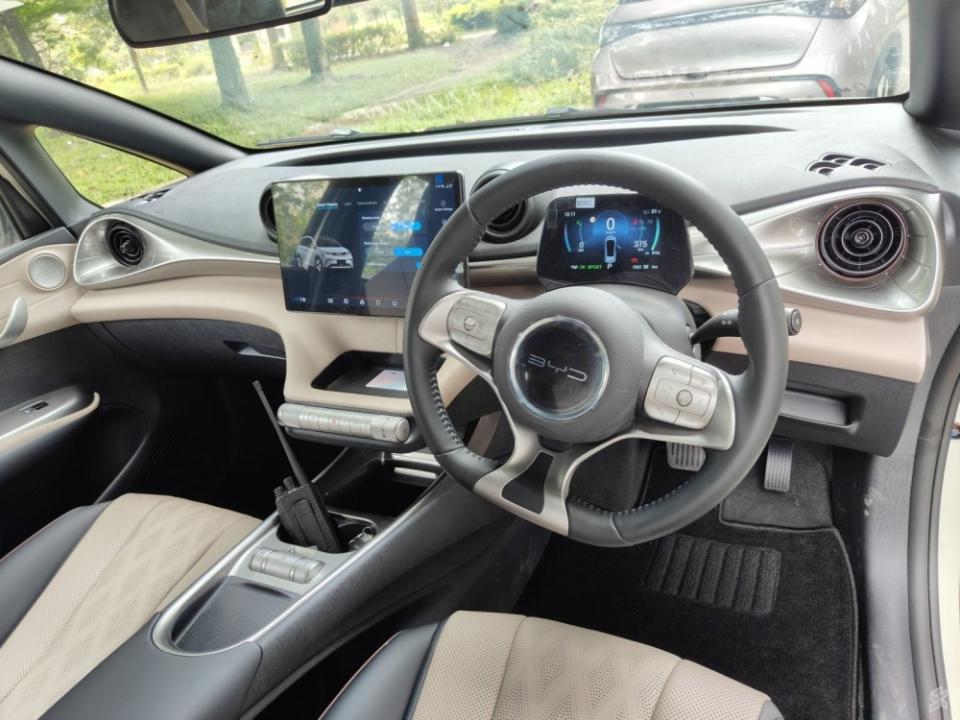
Despite being a “budget” car, BYD has played around with different materials and textures to give it a more upmarket look. In the standard model that we drove, is gets a two-tone interior which has a combination of hard plastics, glossy plastic and soft-touch materials. The top part of the dash is obviously hard plastic but they have added textures which feels what I would describe as hard wood. Meanwhile, the plastic on the internal door trim is given a textile-like texture which is also rather interesting.
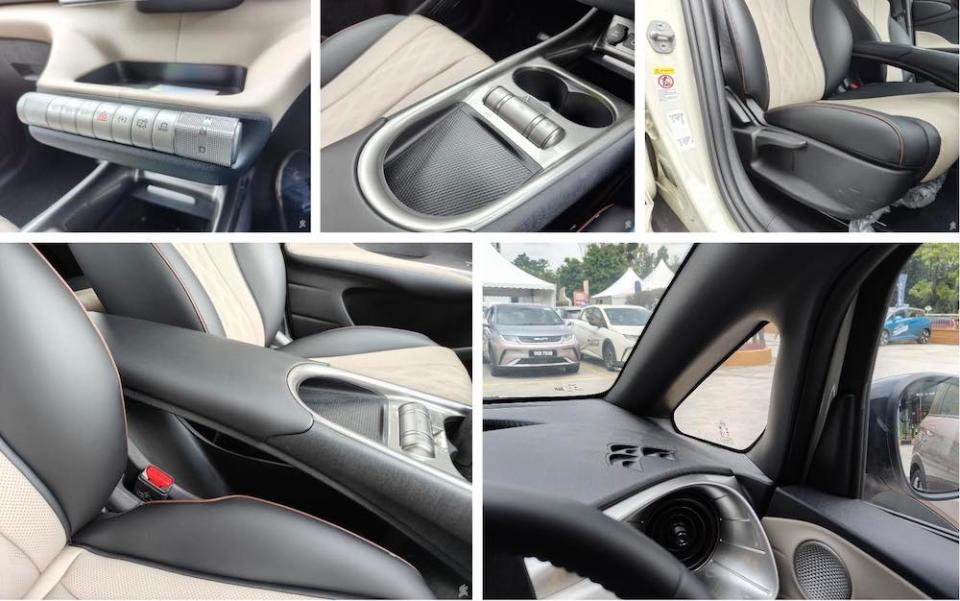
The only quirky bits are the door handle to unlock the car which looks like a Dolphin’s fin and the gear selector to switch between Park, Drive, Reverse and Neutral is a large jog-dial that’s placed in the centre stack towards the driver’s side.
But overall, the Dolphin looks like a decent fully electric hatchback which doesn’t really shout for attention like other EVs. You still get normal door handles on the outside and you can just get in a drive like a normal car without much of a learning curve.
Bigger than it looks
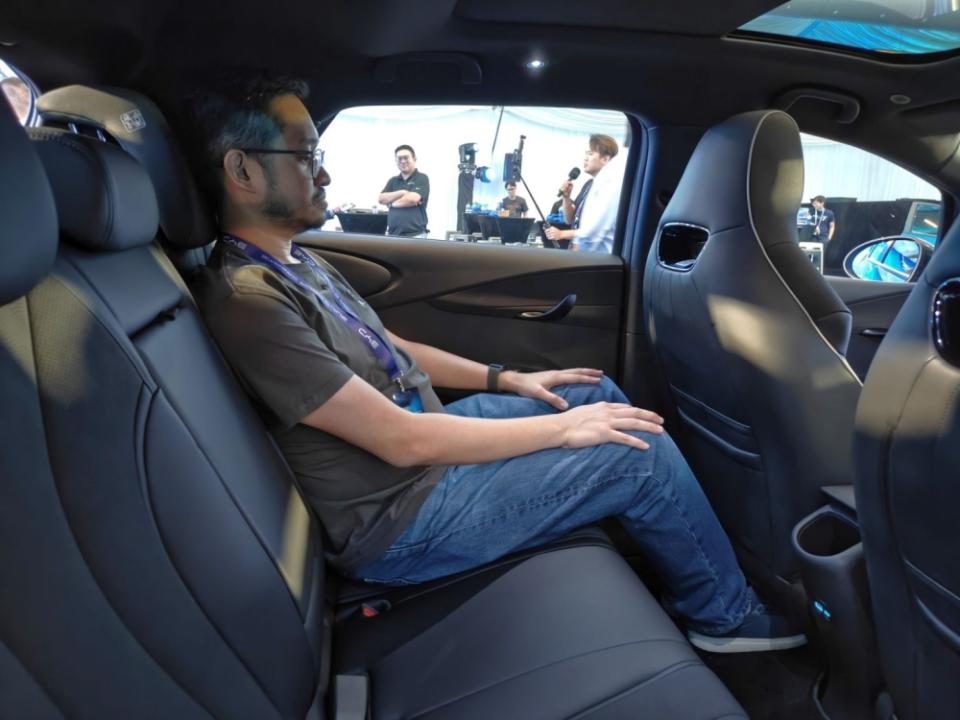
Before seeing the Dolphin in the flesh, I was expecting something like a Myvi since this is a fully electric compact hatchback. Once you see it up close, you’ll notice that this Dolphin is much more spacious thanks to its long 2700mm wheelbase and dedicated EV platform. This means the floor is completely flat as it doesn’t have to make way for the exhaust and transmission tunnel.
Getting into the driver seat, the Dolphin allows a fairly good amount of adjustments as you can adjust the height and reach of the steering wheel. Despite not having power seats for the front, the Dynamic Standard model offers height, tilt and slide adjustments so that you can find the most comfortable driving position. The rear is definitely spacious too and it feels like a car from a larger segment. With my 180cm height, it still offers a decent amount of headroom but loads of legroom and knee room. With my long legs, I wish there was a little bit more under-thigh support for the seats but generally, I can really get comfortable at the back for long-distance drives.
As you would expect for a hatchback, the Dolphin’s boot is quite decent with about 345 litres of space. It is not as big as the Honda WR-V’s 380-litre boot capacity but it is definitely larger than the Honda City Hatchback’s 289-litre boot as well as the Perodua Myvi’s 277-litre boot. There’s more storage underneath the false floor and you can fold the rear 60:40 seats if you need to carry longer items. Similar to the Atto 3, there’s no frunk (front trunk) under the hood of the Dolphin.
More than enough performance for most people
On paper, the BYD Dolphin Dynamic Standard Range’s performance appears to be on par with similar vehicles with a 1.3-litre engine. It has a single front motor that pushes 70kw (94hp) and 180Nm of torque. From our 24km test drive, I can say that the Dolphin does feel quicker than the rated 0-100km/h acceleration time of 12.3 seconds suggests as you can get instant torque from the get-go. Getting from 0-60km/h feels quicker than any other hatchback and going from 60km/h to 110km/h takes a little bit longer and it is delivered in a rather linear fashion. From what we can tell, this single motor is capable to drive the car to over 150km/h which is definitely way more than enough for most people.

The Dolphin Standard gets a 44.9kWh battery with a WLTP-rated range of 340km on a single charge. On the dash display, the Dolphin shows a rather high range of 398km remaining at 97% battery and it seems to be using the more lenient NEDC cycle. During the test drive which is pretty spirited to keep up with the chase car, I managed to get an efficiency of 15.8kWh / 100km, which is pretty impressive. If you drive this sensibly for daily commutes, you should have no problems getting close to the claimed 340km range rating.
The Dolphin Dynamic Standard is tuned for comfort
The BYD Dolphin has a rather soft suspension and it is clearly tuned for comfort. This is great for normal city driving to ferry your family in a more civilised and comfortable manner. Yes, you can have some fun with the instant acceleration but this isn’t a car that you want to go hard around the corners or constantly drive at high speeds on the highway. From my experience with other sub-RM200,000 EVs, the Ora Good Cat and the Hyundai Kona are much more fun EVs to drive as it has the right amount of firmness.
However, we are not sure if the ride comfort and handling are the same as the higher Premium Extended Range model. Besides getting a more powerful 150kW (201hp) and 310Nm motor, the Premium model that costs RM25K more is heavier as it gets a larger 60.48kWh battery and it also gets a multi-link suspension. Hopefully, we can find out soon with an upcoming test drive.
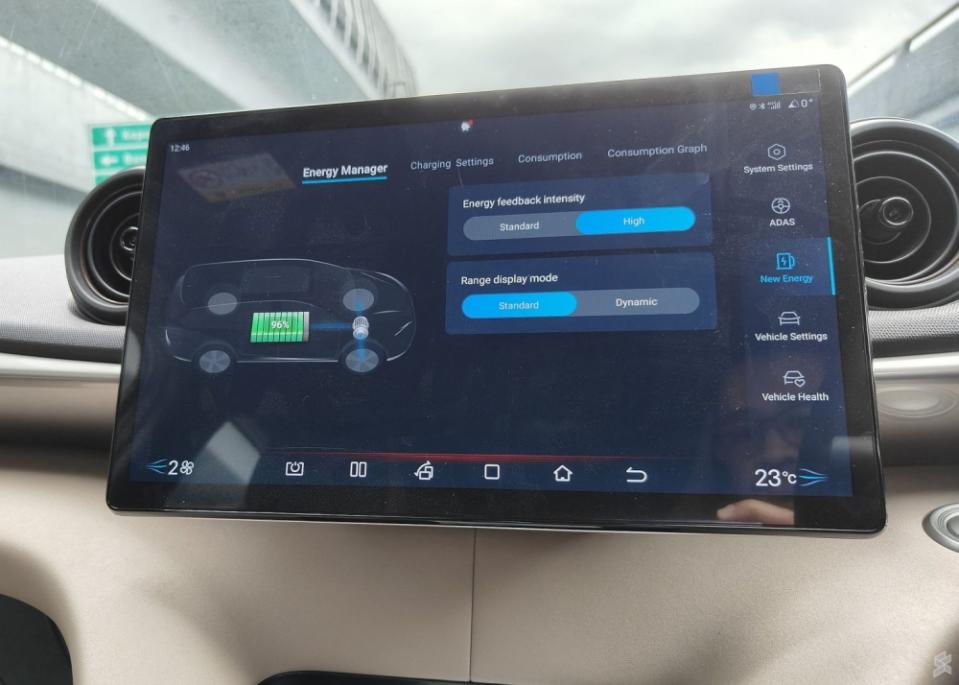
Unlike the Good Cat and the Kona, we can’t seem to get any wheel spin with the Dolphin Dynamic Standard even when we stomp our foot on the accelerator in sports mode. Meanwhile, the regenerative braking level is quite moderate even in its highest setting and the car is set to Sports mode. Personally, I would prefer a little bit more intense regen but it seems BYD is trying to provide a driving experience that’s closer to a petrol-powered hatchback.
No compromise on advanced safety features
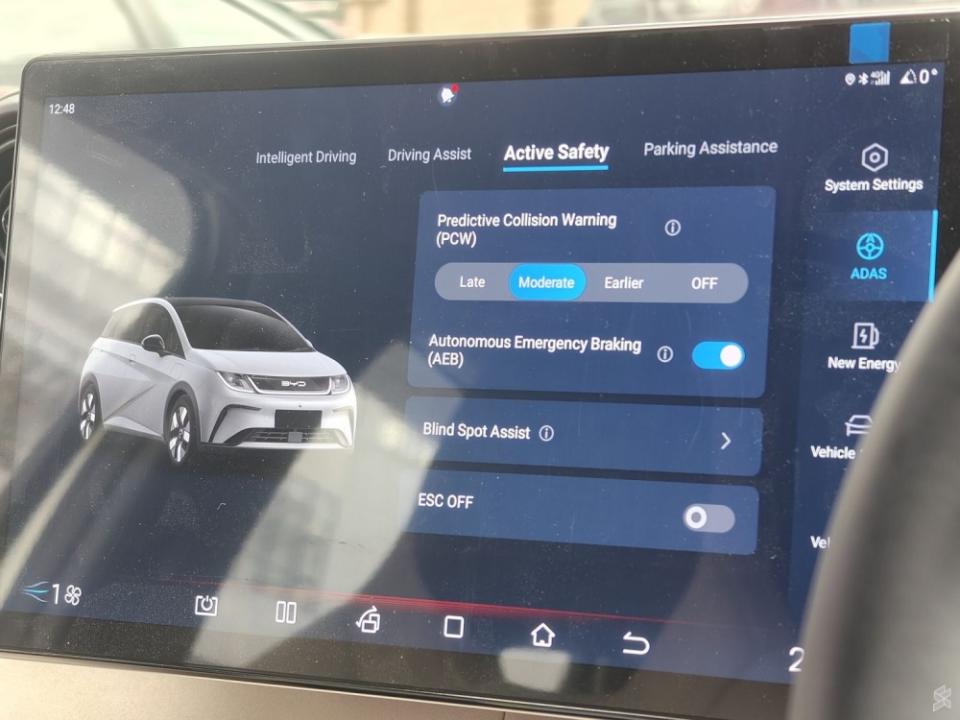
Unlike other carmakers that often reserve the full suite of advanced driver assistance systems (ADAS) for the top-spec model, BYD doesn’t cut corners for its base spec Dolphin Dynamic Standard range variant. It still gets a total of six airbags along with advanced features including Autonomous Emergency Braking (AEB), Adaptive Cruise Control (ACC) with Stop and Go support, Lane Keeping Support (LKS), Lane Change Collision Warning (LCW) and even Rear Cross Traffic Alert (RCTA) and Rear Cross Traffic Braking (RCTB).
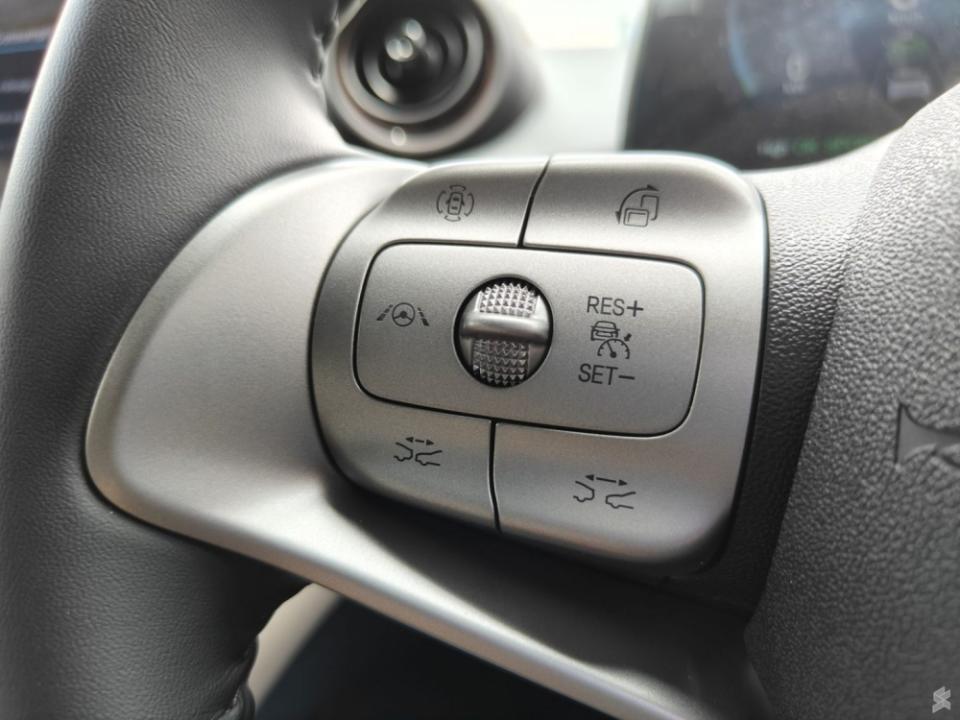
During the test drive, I managed to try out the adaptive cruise control when there’s traffic developing ahead and it does a good job in managing the throttle and keeping a safe distance from the car in front. The feature is quite easy to activate and you can easily adjust the level of distance on the steering. I also managed to try out the lane-keeping assist and it does try to resist you from drifting to the next lane if you didn’t put on the signal indicators. Overall, these safety tech are useful in preventing you from getting into trouble and you can feel that the ADAS kicks in rather strongly.
Small little niggles
While the BYD Dolphin is filled to the brim with tech, the little sound alerts from the system can get overwhelming and sometimes annoying. By default, there’s a speed limit alert which buzzes out randomly and sometimes when the ADAS features kick in, you don’t really know what the warning is about from the tiny 5″ instrument cluster. Most of the ADAS features are represented by tiny icons which are made harder to see when the screen is glaring under direct sunlight.
Sometimes the warning alerts disappear before you can look down on the screen. For example, if you’ve set adaptive cruise control and the car couldn’t detect your hands on the steering, the screen shows a steering wheel icon for a split second without any text read out. Ideally, these warnings should stay on with clear text messages for a longer period of time or until the “issue” has been resolved by the driver.
The default signal indicator audio also sounds artificial and you can also change them from the vehicle settings. Since there’s no engine noise, EVs would typically come with pedestrian warning sounds and the Dolphin does emit a weird sound which sounds like an ice cream truck when it’s moving at low speeds below 30km/h. It is loud enough that you can even hear it inside the cabin as you approach the traffic light. I’m pretty sure there are other options that you can switch to that might sound less annoying.
But overall, this base spec Dolphin with an on-the-road (OTR) price of RM100,530 without insurance is a value buy if you’re looking to buy your first electric vehicle or simply any new car around the RM100,000 price range. Yes, there are some minor annoyances but you can’t deny that this entry-level EV ticks all the right boxes if you need a car for your commute to work and to handle the daily school runs.
While the 340km range sounds limited, it won’t be an issue if you can install a wall box charger at home or if you have easy access to a public charger in your neighbourhood or workplace. There are also several malls with EV chargers where you can perform a quick two-three-hour top-up while having your family dinner or shopping. If you do plan to travel longer distances on a single charge, you might want to consider forking out the extra RM25K for the premium extended-range model that comes with a WLTP-rated range of 427km. — SoyaCincau



